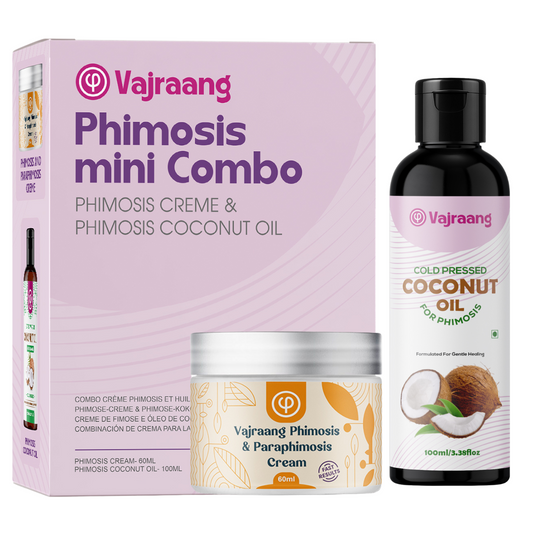Treating phimosis effectively often involves consistent stretching, but supporting it with key lifestyle changes can significantly enhance progress and improve overall outcomes. Beyond stretching, factors like diet, hydration, skincare, stress management, and circulation play a crucial role in promoting skin elasticity and healing. Here’s a guide to adopting holistic practices to complement your phimosis recovery routine.
1. Boost Skin Elasticity Through Nutrition
What you eat directly impacts your skin’s ability to stretch and heal. Including the right nutrients can improve the phimotic band’s elasticity and responsiveness to stretching.
Key Nutrients for Skin Health:
• Collagen-Boosting Foods: Include bone broth, fish, eggs, and citrus fruits to strengthen and support skin elasticity.
• Vitamin C: Found in oranges, strawberries, and bell peppers, this vitamin promotes collagen production and speeds up skin repair.
• Vitamin E: Almonds, sunflower seeds, and spinach protect and repair skin tissue.
• Zinc: Nuts, seeds, and lean meats help in wound healing and reducing inflammation.
• Omega-3 Fatty Acids: Salmon, flaxseeds, and walnuts maintain hydration and reduce irritation.
For more on collagen’s role in recovery, read “Collagen: The Unsung Hero of Phimosis Treatment”.
2. Stay Hydrated
Proper hydration improves skin elasticity and reduces the risk of irritation during stretching.
Tips for Staying Hydrated:
• Drink 2–3 liters of water daily, depending on your activity level and climate.
• Include hydrating foods like cucumbers and watermelon in your meals.
• Limit caffeine and alcohol, which can dehydrate the skin.
3. Maintain a Gentle Skincare Routine
The foreskin and glans require special care to prevent irritation, dryness, or infection during recovery.
Skincare Tips for Phimosis Recovery:
• Daily Cleaning: Wash the foreskin and glans gently with warm water using Phimosis Intimate Wash. Avoid harsh soaps.
• Moisturize Regularly: Use natural moisturizers like Vajraang Extra Virgin Coconut Oil to keep the skin supple and hydrated after stretching.
• Avoid Irritants: Stay away from products with artificial fragrances or alcohol that can dry out or irritate the skin.
4. Manage Stress for Faster Healing
Stress can hinder your body’s natural healing processes by disrupting hormonal balance and increasing inflammation.
Stress Management Techniques:
• Practice mindfulness or deep breathing for 10–15 minutes daily.
• Engage in moderate physical activity, such as walking or yoga, to promote blood flow.
• Prioritize 7–8 hours of sleep each night to support tissue repair.
5. Avoid Habits That Slow Progress
Certain habits can counteract your stretching efforts or delay recovery.
Habits to Avoid:
• Smoking: Reduces blood flow and collagen production, impairing skin elasticity.
• Excessive Alcohol: Leads to dehydration and slower healing.
• Overstretching: Stretching beyond comfort can cause tears and scarring, delaying progress.
Learn more about avoiding complications in “Preventing Paraphimosis and Tears During Phimosis Treatment or Sexual Activity”.
6. Enhance Blood Circulation
Improved blood flow delivers oxygen and nutrients to the skin, promoting healing and elasticity.
How to Boost Circulation:
• Take warm baths before stretching to relax and soften the foreskin.
• Incorporate light exercises like yoga to improve overall circulation.
• Massage the foreskin with Vajraang Extra Virgin Coconut Oil to stimulate blood flow and enhance skin flexibility.
7. Gradual Stretching with Consistency
While lifestyle changes accelerate recovery, regular stretching remains the foundation of phimosis treatment. Tools like Vajraang Phimosis Stretching Rings provide safe, consistent pressure to expand the phimotic band over time.
Tips for Effective Stretching:
• Use lubrication, such as Vajraang Coconut Oil, to reduce friction.
• Stretch daily and gradually increase duration as comfort improves.
• Combine stretching with warm baths or moisturizing for better results.
When to Seek Professional Guidance
If progress is slow or discomfort persists, consult a healthcare professional to explore additional treatments, such as topical creams like Vajraang Phimosis & Paraphimosis Cream or minimally invasive procedures.
The Takeaway
Phimosis recovery is most effective when consistent stretching is paired with healthy habits that support skin elasticity and healing. By focusing on nutrition, hydration, skincare, stress management, and circulation, you can enhance your recovery journey and achieve results more efficiently.
Remember, patience and persistence are key. Every small step counts toward progress, and with the right tools like Vajraang Phimosis Stretching Rings and supportive lifestyle changes, your path to recovery will be smoother and more rewarding.
Start your recovery journey today with confidence and care!






